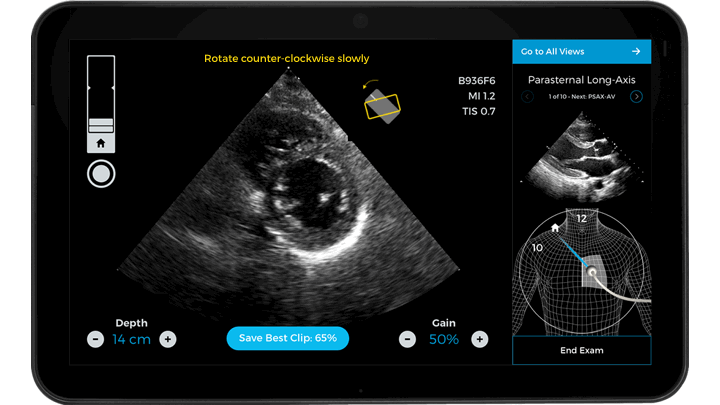
Designing an 'intelligent' ultrasound software to enable novice clinicians into taking better quality scans
CHALLENGE
Currently, due to the large learning curve in ultrasound technology and interpretation, access is limited to highly trained professionals. This in turn delays patient care and increases cost of diagnosis.
DURATION
1 Year
IMMEDIATE TEAM
Design: Ching Hsieh
PM: Ali Chaudhry, Stephen Aman
Engineering: Laura Piersall, Erin McCarty
Clinical: Patrick Brown, Sara Guttas
TOOLS
Research: Fly on the wall, Contextual Inquiry, Empathy Mapping, Service Blueprinting
Design: Sketch, Adobe Illustrator, Principle
User Testing: Qualitative Interviews and Observation
RESPONSIBILITIES
Collaboration with clinical teams to understand problem space; Working on user flows and UI Design; Research and testing with doctors and clinicians; Coordinating with Engineering and QA team for product launch; Managing design efforts with an external agency for the launch of a new product line.

"I'd like to commend you on what you have created here.
You have understood the challenges clinicians in training experience when starting to scan and used the power of AI and design to make ultrasounds - traditionally quite complex- very intuitive to use.
I would highly recommend this product."
- Expert clinician
Current ultrasound systems
Only expert clinicians (with a minimum of 15 years of training) can scan using traditional ultrasounds with ease, and this causes a bottleneck in the medical system.
Medical imaging tends to be very expensive and often quite delayed.
When a novice clinician picks up the probe, they often don't know how to start, where should they place the probe or what they are looking at on the screen.

How does Caption AI address these issues?
The user interface guides a novice clinician from start to finish, synonymous with an expert clinician standing beside them and helping them out with their first complex scan.
The UI presents itself with a number of features serving this goal:

Why is this a hard problem to solve?
A 3 dimentional 'beam' vs a 2 dimentional 'slice'

A million different 'slices' of the heart
Unlike a torch's '3D light beam', a cardiac ultrasound probe scans by only capturing a 2D slice of the heart.
Therefore, any small movement of the probe causes the clinician to capture a different slice.
Each unique slice offers different information, and to diagnose different conditions, the exact slice must be captured.


Research process
Hospital visits and contextual inquiry - really getting into the minds of clinicians to understand pain points and user journeys

Hospital visits
We visited the Cristina Care Hospital system, amongst others to observe clinicians during their workflow, focusing on key moments where a design solution would be ideal.
This helped us define user journeys and opportunities, to then translate into the UI.


User personas
Who are we building for?
What is unique about each type of user that we need to consider?


A simple Google Maps-like navigator for the human body
Explorations of guiding the ultrasound probe through the complex world of organs and bones


Probe placement
For a novice clinician to start a cardiac scan, they need to understand:
1. Where to place to probe on the chest for each type of scan
2. Between what ribs should the probe be placed
3. Which direction should the probe indicator be facing
Caption AI's probe placement diagrams (visualized like a clock) helped novice scanners with the basics of scanning, removing anxiety, increasing efficiency and accuracy.


Probe movements
Created a unique proprietary system to translate the 3D movement of the probe into easy-to-understand 2D visuals.
Clinicians have a few milliseconds to look at these illustrations in the middle of scanning a patient, and therefore they need to be very simple.



Designs
From old to new - revolutionizing the way clinicians conduct medical imaging for the heart.

"Ultrasound machines are too complicated"
Conventional ultrasound relies on an expert eye to recognize anatomical structures, limiting access to a subset of clinicians with years of specialized training. Caption AI helps 'simplify' these functions using a user friendly interface.
"Where do I even start??"
For each view, Caption AI provides a probe positioning diagram indicating where and how to place the probe. A reference image provides a visual example of what to look for while scanning.


"I would definitely need training to do this"
Caption AI emulates the guidance of an expert sonographer by providing real-time feedback and adaptive instructions, which prompt users to make specific transducer movements to optimize and capture a diagnostic-quality image.
"Is this image good enough?"
The Quality Meter lets users see in real time how close they are to capturing a diagnostic-quality image. The meter rises as the user gets closer to the optimal view, turning green when the image is deemed diagnostic. AutoCapture then records the clip, hands-free.


"Can I go back to where I was?"
Caption AI continuously keeps track of the best images seen during each scanning session so the best image from each view is automatically captured. Users have the freedom to explore each view with the reassurance that they can always access the best clip seen during their scan.
I would love to chat more regarding my in-depth process.
If you're interested, please contact me at tithi.jasani93@gmail.com or using the form below.